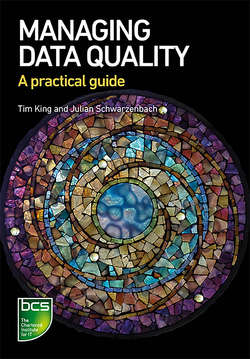Читать книгу Managing Data Quality - Tim King - Страница 33
На сайте Литреса книга снята с продажи.
ОглавлениеChallenges when exploiting and managing data
17
turn should improve the quality of the decision making of the organisation and, in turn, should lead to better results or outcomes. With better decisions and results, it is likely that the data arising from these activities will also be better quality, particularly in more ‘data aware’ organisations.
Unclear data ownership
Some people talk about ‘data owners’ and organisations often worry about assigning ownership to particular data sets. Since many business processes can create, use and amend similar data (e.g. customer data being updated as part of many processes), an assigned owner of data will struggle to retain influence over the activities that are changing the data and contributing to poor quality.
By assigning empowered process owners and maintaining explicit specifications for the data being created by a process, organisations can establish a more solid foundation for the control of data quality. If such data specifications have been defined, agreed and published to reflect the decisions being supported by the data, it becomes possible to assess compliance objectively. Many individual sources (e.g. different suppliers or departments) can then contribute to the data, but always in accordance with the single, definitive data specification.
Managing data storage is not ownership; effective owners are those who can determine the extent to which data are appropriate for the needs of the business.
Backups and data quality
All well run information technology (IT) systems will have an agreed backup regime in place, ensuring the organisation is able to restore a full or partial system in the event of major hardware or software issues. This will typically include a range of daily, weekly and monthly backups, plus off-site storage and perhaps standby ‘failover’ systems, to ensure that if, for example, there were to be a fire on site, software systems and services could still be restored from scratch without undue delay or data loss. Backups can vary from a ‘full’ backup (copying all data and information to backup media) through to an ‘incremental’ backup that only copies data and information that have changed since the last backup was run.
Depending on the backup service level agreement, the data backups can usually give a view of the data from one or two months ago. However, if you were to try and restore your data to a backup from some time ago, you will almost certainly ‘lose’ all the data updates that have been made since the backup was created. Such a scenario requires both the application of incremental restores and the analysis of which updates to ignore and overwrite.
If staff have been entering poor quality data over a significant period of time (perhaps over many years), then it will be extremely difficult, if not impossible, to go back to a point where the data were ‘good’ and find the correct data. This is particularly challenging
